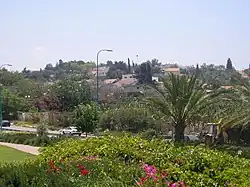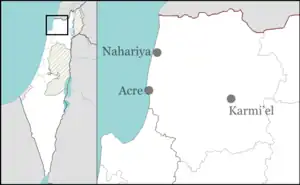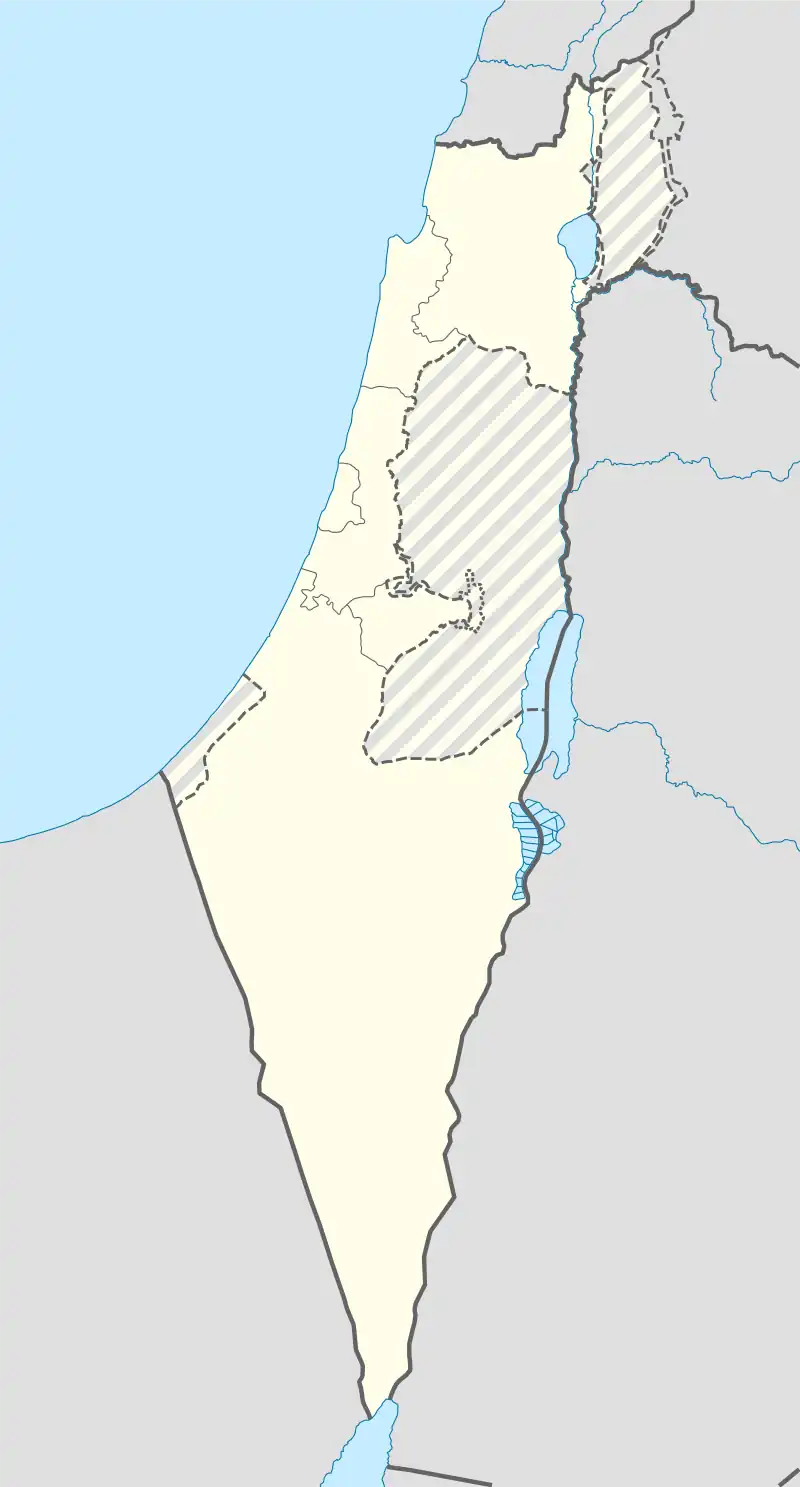Shlomi
שְׁלוֹמִי | |
|---|---|
| Hebrew transcription(s) | |
| • ISO 259 | Šlomi |
| • Also spelled | Shelomi (official) |
 | |
 Shlomi  Shlomi | |
| Coordinates: 33°4′28″N 35°8′41″E / 33.07444°N 35.14472°E | |
| Country | |
| District | Northern |
| Founded | 1950 |
| Government | |
| • Head of Municipality | Gabi Naaman |
| Area | |
| • Total | 5,868 dunams (5.868 km2 or 2.266 sq mi) |
| Population (2021)[1] | |
| • Total | 7,055 |
| • Density | 1,200/km2 (3,100/sq mi) |
Shlomi (Hebrew: שְׁלוֹמִי) is a town in the Northern District of Israel. In 2021 it had a population of 7,055.
Name
Shlomi was named after a leader from the tribe of Asher, mentioned in the Hebrew Bible (Num 34:27).
History
.jpg.webp)
Shlomi was founded as a development town in 1950 by Jewish immigrants from Tunisia and Morocco on the ruins of a Palestinian village of al-Bassa, which had been destroyed during what the Palestinians - identify as the Nakba or catastrophe and what Israelis call 1948 Arab–Israeli War,[2][3][4] and which Adolf Neubauer "proposed to identify... with the Batzet of the Talmud".[5] The Palestinian Arab village was stormed by Haganah troops in May 1948 and almost completely razed. Its residents were either internally displaced or expelled to neighboring countries.[6]
Shlomi was the target of Hezbollah Katyusha rocket attacks on 11 May 2005, Israel's Independence Day, and again on Israel's Independence Day in 2006.
It was again the target of rocket attacks on 12 July 2006, a diversion to facilitate the killing of three soldiers and kidnapping two others, which sparked the 2006 Lebanon War.
On the 6th of April 2023 several rockets hit the town and caused damage to a street and a commercial center.
2023 Israel–Hamas war
During the 2023 war between Hamas and Israel, northern Israeli border communities, including Shlomi, faced targeted attacks by Hezbollah and Palestinian factions based in Lebanon, and were evacuated.[7]
Archaeology
On the road between Shlomi and Kibbutz Hanita, Israeli archaeologists found the remains of Pi Metzuba, a prosperous Christian town mentioned in the Jerusalem Talmud,[8] the Tosefta (Shevi'it 4:8-ff.) and in the 3rd-century Mosaic of Rehob.[9] The town was destroyed in the early seventh century when Persia invaded the region as part of its broader conflict with the Byzantine Empire.[8]
References
- ↑ "Regional Statistics". Israel Central Bureau of Statistics. Retrieved 22 February 2023.
- ↑ Benvenisti, Meron (2002). Sacred landscape: the buried history of the Holy Land since 1948. University of California Press. p. 193. ISBN 978-0-520-23422-2.
- ↑ Morris, Benny (2004). The Birth of the Palestinian Refugee Problem Revisited. Cambridge University Press. p. 253. ISBN 978-0-521-00967-6.
- ↑ "History of Shlomi". Archived from the original on 2016-03-03.
- ↑ Neubauer, 1868, p 22. References: Tos. Shebiit 4:9, Yer. Demai 2:1 (Heb. 8b). See also Grootkerk, 2000, pp. 2–3 and Conder and Kitchener, 1881, SWP I, p. 167
- ↑ Bardi, Ariel Sophia (March 2016). "The "Architectural Cleansing" of Palestine". American Anthropologist. 118 (1): 165–171. doi:10.1111/aman.12520.
- ↑ Fabian, Emanuel. "IDF to evacuate civilians from 28 communities along Lebanese border amid attacks". www.timesofisrael.com. Retrieved 2023-10-22.
- 1 2 Christian Town Destroyed by Persians 1,400 Years Ago Found in Northern Israel, Ariel David for Haaretz, 17 June 2020. Re-accessed 6 April 2023.
- ↑ Haltrecht, Ephraim (1948). "Pi-ha-Masuba". Bulletin of the Jewish Palestine Exploration Society: Israel Exploration Society: 43. JSTOR 23727325..
External links
- History of Shlomi Archived 2016-03-03 at the Wayback Machine (in Hebrew)
.svg.png.webp)